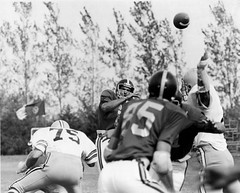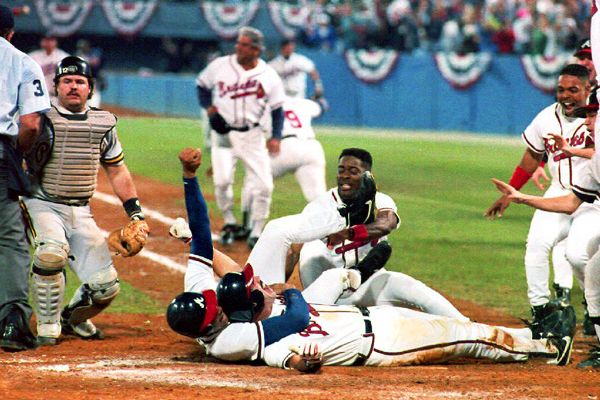John Heisman and the art of educational innovation
As a rather eventful week winds down, I'd like to return to a thread I started weaving last weekend shortly after Troy Smith won this year's Heisman Trophy.
 Law School Innovation and the Wall Street Journal's Law Blog have both taken note of one facet of the remarkable life of the Heisman Trophy's namesake. John Heisman went to law school, receiving his LL.B. from the University of Pennsylvania in 1892. Like Gottfried Wilhelm Leibniz, Heisman was a polymathic genius who happened to study law. Like Scott Boras, Heisman bypassed the legal profession in favor of a daring career in sports.
Law School Innovation and the Wall Street Journal's Law Blog have both taken note of one facet of the remarkable life of the Heisman Trophy's namesake. John Heisman went to law school, receiving his LL.B. from the University of Pennsylvania in 1892. Like Gottfried Wilhelm Leibniz, Heisman was a polymathic genius who happened to study law. Like Scott Boras, Heisman bypassed the legal profession in favor of a daring career in sports.So what exactly did Heisman do in football? The New York Times' recent profile of Heisman summarizes his accomplishments:
Aside from leading the fight for the legalization of the pass in the early 1900s, Heisman pushed to divide the game into quarters and created the center snap. The ball had previously been rolled on the ground. Heisman introduced the ''hike'' vocal signal and the first audible at the line. He invented the hidden ball trick and what would now be called the fumblerooski. Because he wanted fans to understand play-calling, he made it easier for them to follow the downs and yardage needed by erecting something else new at games: a scoreboard.Among those innovations, of course, Heisman's signature contribution to the sport was the forward pass. As the New York Times mentioned, and as Wiley Lee Umphlett documented at great length in Creating the Big Game: John W. Heisman and the Invention of American Football (1992), the forward pass probably saved the sport from extinction. From 1904 to 1905, according to the Times, "44 players [were] reported killed in football games, with hundreds sustaining serious injuries." Heisman advocated the forward pass as a way of "scatter[ing] the mob."


The forward pass utterly revolutionized football. The threat of a quick-strike, "vertical" game -- one in which a thrown football could move a team the length of the field if the quarterback hits an eligible receiver in stride -- neutralizes defenses based on size and brute strength. You can't stack eight men in the box when the offense forces you to respect the pass. The forward pass guarantees that fast, thin players can compete on roughly equal footing with strong, heavy players. The threat of the forward pass animates deceptive plays such as the draw and the play-action pass. Those plays, after all, are mirror images of each other: the draw is a run that looks like a pass, and play-action lets the quarterback pass after tricking the defense into stuffing the run.
 Everything since Heisman, truth be told, has been a variation on the theme of integrating the forward pass into a sport that would otherwise be a stop-and-go version of rugby. Offensive strategies such as the spread offense, the option offense, and the West Coast offense represent different strategic ways of exploiting a team's strengths and an opponent's weaknesses vis-à-vis the forward pass. The no-huddle offense and the audible are tactical innovations that enable a team to respond to highly variable conditions during the game.
Everything since Heisman, truth be told, has been a variation on the theme of integrating the forward pass into a sport that would otherwise be a stop-and-go version of rugby. Offensive strategies such as the spread offense, the option offense, and the West Coast offense represent different strategic ways of exploiting a team's strengths and an opponent's weaknesses vis-à-vis the forward pass. The no-huddle offense and the audible are tactical innovations that enable a team to respond to highly variable conditions during the game.So what does all this have to do with legal education and, in particular, innovation in legal education? Quite a few points come to mind, but these seem most pressing for the moment:
- There are significant differences between structural, strategic, and tactical innovations. The forward pass is foundational and structural; its emergence changes the sport. The choice between offensive game plans -- say, an option offense versus the Fun 'n' Gun -- enables a coach to plan at a highly abstract, strategic level. Innovative formations, individual plays, and the shrewd use of audibles all belong to the tactical level of the game.
- No single set of strategies and tactics works for every game, let alone every play. Defenses can be just as innovative as offenses. It similarly behooves a law school to retain its options across a wide range of pedagogical and scholarly tools. Clinical education? Intense skills training? Empirical research? Externships? Joint degree opportunities? Sure. All of that and more should be found in every law school's operational arsenal.
- Both football and legal education are profoundly conservative. With very few exceptions, football coaches continue to treat the forward pass as a deviant play, as though John Heisman had not existed. Similarly, the Langdellian model of legal education continues to hold sway, despite a grumbling, grudging consensus that the case-based, Socratic classroom falls far short of providing contemporary law students with comprehensive training.
Photo credit: The image at the top of this post is part of the collection of The New Georgia Encyclopedia. John Heisman, who also coached baseball and basketball in addition to football, is the man in the middle with the megaphone.













1 Comments:
Jim -- You note that football teams have a wide variety of skill sets, and that "[i]t similarly behooves a law school faculty to retain its options across a wide range of pedagogical and scholarly tools." At the same time, however, most football teams have some sort of "identity" -- a focus on a particular sort of offense or defense, or an emphasis on one or the other. In fact, teams that lack such a focus are often criticized for failing to have an identity. Do you think law schools need to develop an identity -- namely, a focus on particular subject areas or skills sets?
Post a Comment
<< Home